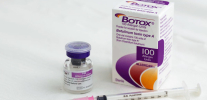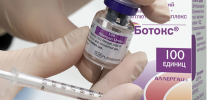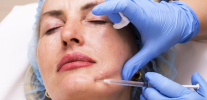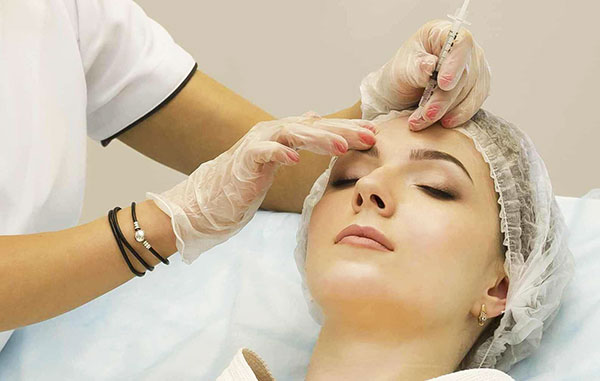
In modern cosmetology, Botox injections are the same common procedure as, for example, eyebrow tattooing, various peels and haircutting. In almost every city there is a clinic (and often more than one) in which you can give yourself such injections. Many women proudly demonstrate the result of botulinum therapy to their girlfriends, and almost every city dweller has a friend who once gave herself Botox injections, or does them regularly.
At the same time, many people have a completely misconception about botulinum therapy itself. Someone believes that it is precisely because of such injections that the face “inflates”, like Hollywood stars who played with plastic surgery, someone is convinced that Botox injections are extremely dangerous for health and cause terrible side effects, but it seems to someone that the price of these injections is acceptable only to millionaires.
In general, the practice of cosmetologists shows that the less a specific person knows about Botox injections, the more ridiculous fears and myths about them that he is inclined to take seriously.
In fact, the introduction of botulinum toxin preparations as a cosmetic procedure is quite safe and effective. Such injections really help get rid of many wrinkles that appear in almost every person at one or another age. And as a medical procedure, Botox injections may be necessary for some pathologies. They have a low cost and are carried out even in children's hospitals according to certain indications.
To have an adequate understanding of what botulinum therapy is, what to expect from it and how it is carried out is the same necessity for a modern person, how to know, for example, how a filling is placed in a tooth. Therefore, let's take a closer look at this cosmetology method in order to obtain objective information about it.
What is useful to know about Botox injections in the first place
In cosmetology, injections of Botox and its analogues are the introduction of botulinum toxin preparations into the muscles, which leads to persistent and long-term relaxation of these muscles and the associated desired effects.
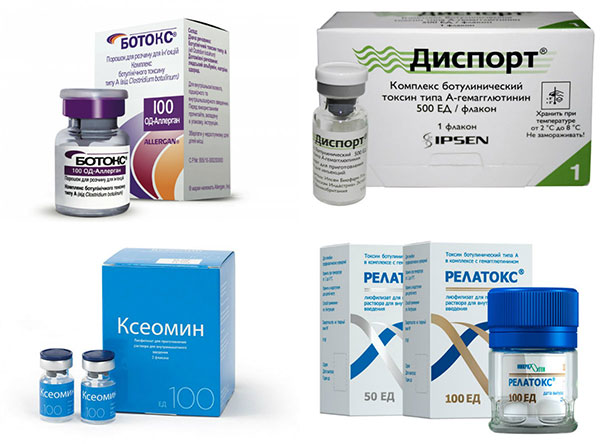
Drugs containing botulinum toxin and used for long-term muscle relaxation.
In particular, if the drug is injected into the facial facial muscle, the frequent and severe reduction of which leads to the formation of wrinkles or several wrinkles, then after relaxation of the injected muscle with Botox, these wrinkles disappear.
Also, the relaxation of individual muscles or their entire groups with botulinum toxin allows you to achieve other effects:
- To smooth too rough, bulging muscles (for example, to make the lower jaw less "square" or the calves pumped over the legs more feminine);
- Correct face contour;
- Eliminate facial asymmetry;
- To increase or decrease the eversion of the upper lip and thus eliminate the gingival smile or a defect such as too narrow lips;
- Avoid scarring at the site of surgical scars.
These are just some examples of the effects achieved either using Botox alone, or using a complex that includes Botox injections and other cosmetics. It is not surprising that such injections are also called “beauty injections” - they really help to eliminate many noticeable appearance flaws.
And for medical purposes, Botox is used to treat diseases and syndromes associated with uncontrolled muscle contraction.
It is interesting that the word “Botox” today has become a kind of eponym - it refers to all botulinum toxin preparations, although in its narrow sense Botox is the name of the very first and by far the most common such drug.It is manufactured by the American company Allergan, and competitive products are produced in France (Dysport), Germany (Xeomin), Russia (Relatox), as well as the United States (Mioblock), China (Lantox), South Korea (Neuronox) and other countries. Nevertheless, because of its enormous popularity, the word “Botox” even means the injections themselves, saying, for example, “I will make Botox the day after tomorrow.”
In any case, all botulinum toxin preparations have a fairly similar composition and differ only in details.
The active substance of most of these drugs is purified botulinum toxin type A. It, entering the muscle fibers during injection, penetrates the nerve synapses (the contact points of the nerve and muscle cells) and blocks the transmission of impulses from the neuron to the muscle. Thus, even if an impulse is sent, the muscle does not respond to it. As a result, the muscle is neither contracted nor involuntarily contracted under any conditions.
By the same principle, the toxic effect of botulinum toxin is realized. It is known that this substance is one of the most powerful poisons in nature. But the poisoning of a person or animal, called botulism, occurs only when the poison enters the heart muscle or diaphragm with blood from the digestive tract. In this case, the work of these muscles is disrupted and the person dies either from cardiac arrest or from suffocation.
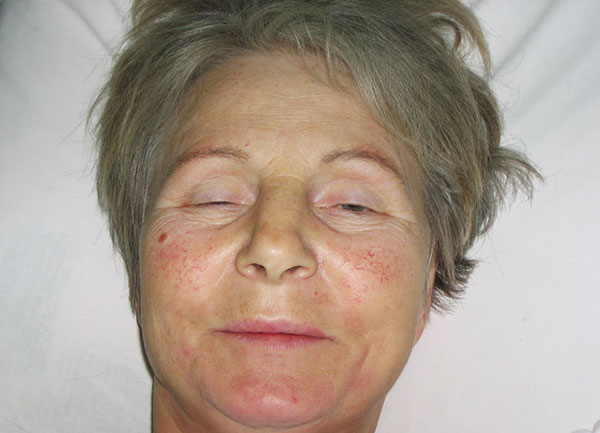
Poisoning a person with botulinum toxins suggests a complete lack of muscle motor activity.
With Botox injections, such an effect of botulinum toxin is excluded - it is introduced into the muscles in such small quantities that it is completely distributed only in the target muscles, without penetrating deep into the body and not affecting vital organs.
The same action of botulinum toxin, which helps to remove wrinkles and which causes death during poisoning, in some cases leads to undesirable side effects. Sometimes such effects are of a different nature, and in some situations due to the action of other components of the drug. In general, side effects during botulinum therapy occur quite often, but for the most part they are insignificant, quickly disappear and do not affect its final result.
Scopes of botulinum therapy
Most often, botulinum toxin is injected for cosmetic purposes to remove facial wrinkles, as well as wrinkles on the neck (the so-called Nefertiti lifting) and on the chest in the decollete. In most patients, for the complete removal of even fairly deep creases on the skin, only Botox injections are sufficient, without the use of additional methods and tools.
Also injections of botulinum toxin preparations can be carried out with other cosmetic purposes, such as:
- Expansion of the palpebral fissure and the effect of large eyes;
- Correction of the asymmetry of the eyelids and eyebrows;
- Elimination of gingival smile;
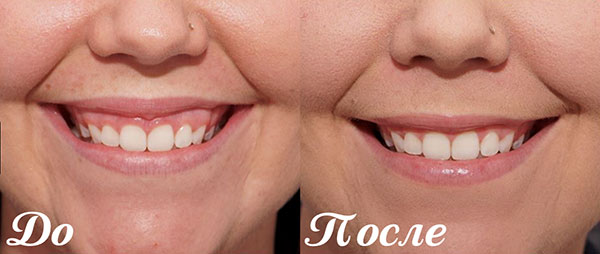
Botulinum toxin injections are used to correct gingival smiles.
- Correction of asymmetry of lip movement during a conversation;
- Smoothing tuberosity on the chin;
- Smoothing the pronounced muscularity of the lower jaw, changing the lower part of the oval of the face;
- In combination with fillers - the elimination or reduction of the severity of the double chin;
- General facelift.
Considering that different cosmetic defects can be caused by various reasons, not only Botox is not always enough in the cases listed above, and therefore injections are often combined with other procedures, for example, the introduction of fillers.
Another vast area of application of Botox is at the intersection of medicine and cosmetology. For example, injections of botulinum toxin preparations can be carried out:
- With bruxism, when the constant clenching of the jaws leads, on the one hand, to coarsening of the lower jaw, and on the other, to increased abrasion of the teeth;
- With hemifacial spasm, nerve tics;
- With blepharospasm;
- With hyperhidrosis (excessive sweating).
Finally, Botox injections are typical medical procedures that allow for the effective treatment of such diseases:
- Spastic torticollis (including in children);
- Horse foot syndrome with cerebral palsy;
- Strabismus;

Injections of botulinum toxin can correct strabismus.
- Arm muscle tremors, especially in patients after a stroke;
- Migraine (it is interesting that there is still no explanation of the mechanism of the effectiveness of botulinum toxin in this case - doctors just found that patients who inject Botox for cosmetic purposes partially or completely pass regular headaches);
- Urinary incontinence caused by hyperactivity of the detrusor muscle of the bladder and usually developing in adults.
In all these situations, Botox and its analogues are used more and more often due to their main advantages: the speed of the onset of the desired effect, its severity and duration of storage.
What results can really be obtained with injections of botulinum toxin preparations
Botox injections can completely eliminate the so-called dynamic wrinkles, that is, those that are formed at the site of wrinkling of the skin with the contraction of certain muscles.
In some cases, Botox (often in conjunction with other means) also removes wrinkles of a different nature - for example, gravitational, if their appearance is somehow connected with excessive muscle activity. For example, the well-known “nasolonger” cannot be eliminated only by Botox, but with the help of botulinum therapy, it is possible to weaken the muscles of the neck and lower face, which pull the cheeks down and lead to the formation of a nasolabial fold. In this case, the wrinkle, if it does not disappear completely, at least becomes less noticeable, and additional injections of fillers can completely hide it.
Yet most often Botox is injected precisely in order to completely smooth out dynamic wrinkles. So, with its help they successfully eliminate:
- Horizontal folds on the forehead;
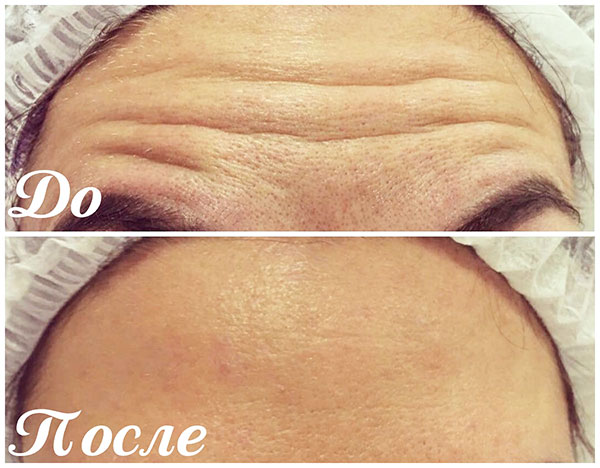
Botox effectively eliminates forehead wrinkles: the upper photo is the forehead in tension before the procedure, the lower photo is the forehead in tension after the procedure.
- A vertical brow wrinkle or several creases here;
- Small wrinkles in the outer corners of the eyes (the so-called crow's feet);
- "Rabbit wrinkles" appearing on the back of the nose when expressing disgust or fear;
- Vertical wrinkles above the upper lip;
- Horizontal folds under the lower lip;
- Horizontal lines on the neck (Venus rings) and strongly pronounced vertical cords on it;
- Mounds on the chin.
In some of these wrinkles in the early stages of their development, it is enough to inject a minimal amount of the drug to completely eliminate them. Due to muscle deactivation, the skin will no longer jam and no folds will form on it, which without treatment begin to deepen and become noticeable even when the muscles are not contracting.
For example, the photo below shows the patient's face before treatment with an eyebrow wrinkle Botox and 2 weeks after injection:
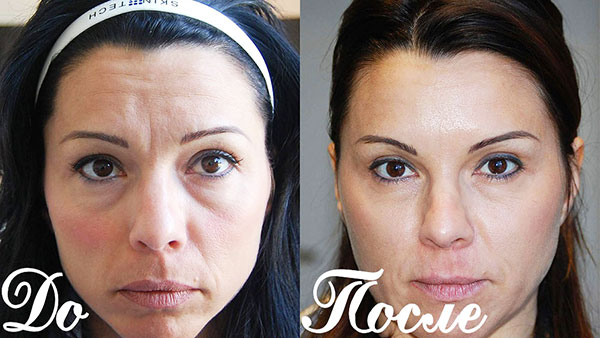
In combination with other methods, Botox is used to eliminate other wrinkles:
- Nasolabial folds, if one of the reasons for their appearance in a particular patient is muscle activity of the neck or lower jaw;
- "Puppet Lines" descending from the corners of the mouth along the sides of the chin.
As you can see in the photo below, after Botox injections, the “nasolongs” became less pronounced, but did not disappear completely:
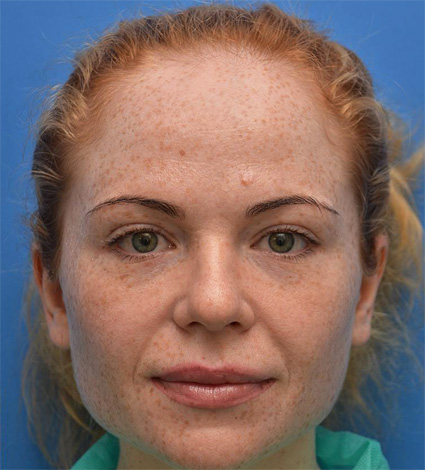
And after an additional facelift, they became almost invisible:
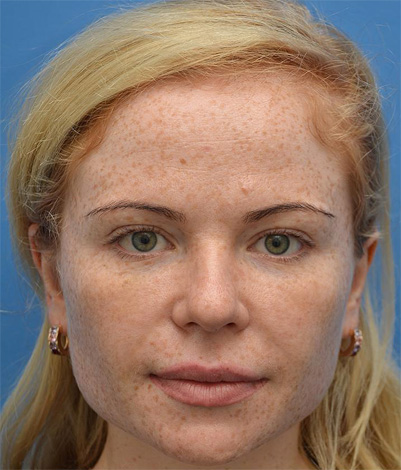
Similar to the elimination of dynamic wrinkles, the asymmetry of the position of the eyelids, spastic curvature of the face, strabismus caused by excessive activity of the eye muscles, and other similar defects are completely eliminated after the first botulinum treatment.
On a note
There is evidence that Botox is sometimes used for baldness.However, there is no scientific confirmation of the corresponding properties of this remedy, nor is anything known about official services to combat baldness with its help.
After those procedures in which Botox is used in conjunction with other means, the desired results can manifest themselves to varying degrees and be achieved at different times.
Interestingly, with cosmetic purposes Botox is not necessarily injected only in the face and neck. Widespread methods of its introduction into the muscles of the arms and legs, in the shoulders - wherever the muscles of the patient can be overstrained and look too rough. Moreover, if the purpose of the injection is not the elimination of wrinkles, namely, smoothing the contours of the body, then the result of the procedure will be saved much longer.
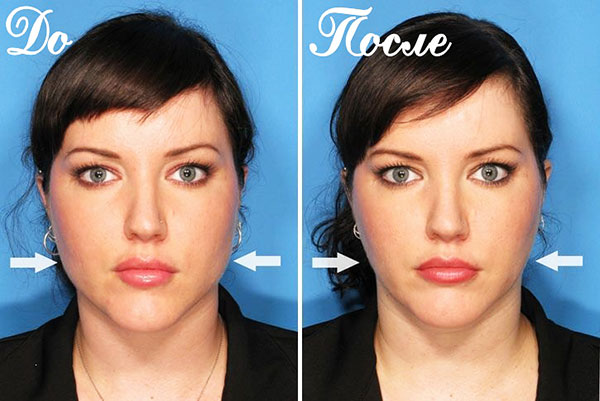
Botox can correct the oval of the face.
Feedback
I have wrinkles on my forehead and between my eyebrows since childhood. At the age of 15, I underwent eye surgery, after which photophobia developed and in strong light I have to constantly squint. Because of this, I already went to deep institutes in the institute. At 25, Botox started stabbing and solved the problem. The issue price is about 3,000 rubles once a year. And if you stop stabbing, for about another six months, wrinkles do not appear, only then do the strips become visible. But I prick every year to prevent the skin from wrinkling here in principle. And now a new nuance has appeared: from the age of 30, the lower jaw began to stand out very strongly, when looking at the mirror it is directly very wide. The doctor explained to me that the problem here is that I often chew something hard (I really like dried fruits), the muscle trains and becomes big, sways. Need a correction. Once pierced the muscles themselves under the ear, where the nodules go, and the temporal muscles. At first it was unusual, because chewing was somehow hard. Then I got used to it. Plus, for lifting, I pricked several points on my neck. Honestly, the effect was “Wow!”. I did not think that Botox could. Three months later, I had an oval face, as in 14 years. I just forgot that you can look so good. And so it has been holding for six months now. I think that even if wrinkles appear, they will not especially spoil it.
Kristina, Moscow
Does the effect of the procedure manifest itself quickly and how long does it last
If Botox is introduced to eliminate dynamic wrinkles, the effect of the injection becomes noticeable already on the 2nd-3rd day. In some cases, the result manifests itself even earlier, but sometimes and vice versa, its onset must wait 5-7 days.
Theoretically, a botulinum toxin preparation needs about 6-8 hours to spread in the target muscle, and the same amount to cause its complete relaxation. In real conditions, around this time, the result becomes noticeable: the patient goes to the procedure in the middle of the day, and the next day in the morning he notes the absence of folds even when trying to express emotions.
It is interesting that the rate of onset of the desired effect is almost the same for all botulinum toxin preparations, but this effect persists in different cases for an unequal time. The fact is that during muscle denervation Botox triggers the formation of new nerve synapses between neurons and the injected muscle. After a few months, their number becomes sufficient so that the muscle begins to respond to impulses from the brain, and after a few months its activity is restored almost completely and wrinkles appear again.
So, with injections of Botox itself and its full analogues - Relatox, Neuronox and others - the result obtained lasts 7-10 months, and in some patients up to a year. Dysport injections give a result lasting about 5-8 months.
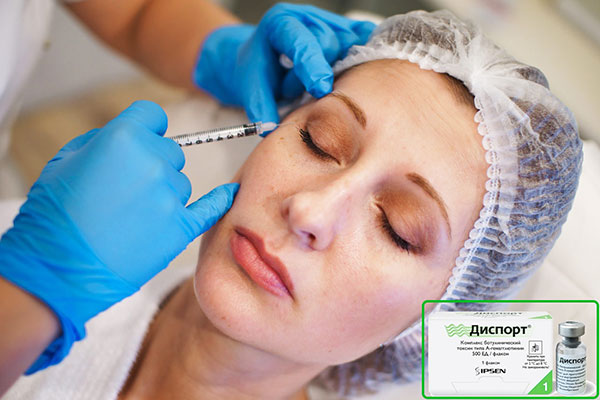
The duration of the effect of Dysport injections is from 5 to 8 months.
To a large extent, the duration of the effect is affected by the metabolic rate of a particular patient, as well as the amount of drug administered. In people with an active metabolism, the effect is faster than in patients with a slow metabolism. And the more funds were injected, the more nerve synapses were deactivated and the more time it will take for the body to create and activate new ones.
There are cases when the effect of Botox injections lasts very little time (from several weeks to 2-3 months) or does not appear at all. This is usually associated with an individual body reaction to botulinum toxin, and it is almost impossible to increase these periods in any way.
On the contrary, if Botox injections are performed to correct facial contours, then the effect of the procedure can last for years. For example, if the drug is injected into the muscle leading to the lower jaw, in order to reduce its size and round the jaw on the sides, then in six months or a year the muscle will lose part of its volume due to lack of load, and in the future even after restoration of activity or more than a year, he will gain the previous volume, or he will not gain it at all if the patient abandons some habits (for example, constantly chewing gum) or cures the causes of bruxism. In the latter case, the effect of botulinum therapy will remain until the end of life.
Botox and its analogues: similarities and differences
The drug Botox from Allergan was the first botanical toxin based product, which was first used in medical practice and then in cosmetology.
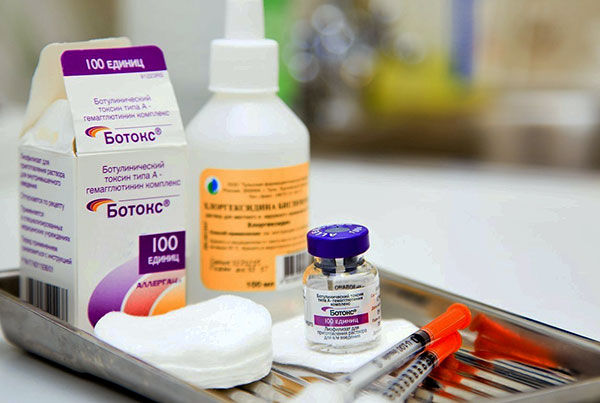
The American drug Botox was originally used for medicinal purposes.
Initially, Botox used to treat facial muscle cramps and develop techniques to combat various nervous disorders leading to muscle hypertonicity. And it was during the treatment of patients that doctors found that when injected into the facial muscles, they completely or partially smoothed facial wrinkles. And a few years after this discovery, more Botox was used to eliminate wrinkles in cosmetic clinics than it was used for medical purposes.
On a note
We can say that it was wrinkles that made it possible to earn multi-million dollar fortunes for owners, founders and investors of Allergan. At that time, when in 1992 several American doctors discovered Botox’s ability (at that time it was called Oculinum) to remove wrinkles on the bridge of the nose and began researching these properties of the drug, the company was a small production with a turnover of several hundred thousand dollars a month. The surge in demand for Botox after the beginning of its active use in cosmetology led to an avalanche-like growth in company revenue. In 2015, Actavis bought Allergan for $ 70 billion.
In the wake of the growing popularity of Botox, many pharmaceutical companies in the world began to enter this rapidly growing market and produce their own analogues of the drug. So there were funds that today are considered sales leaders, second only to Botox in popularity. It:
- Dysport is a product of the French company Ipsen. It is known for the fact that its dosage unit has a less pronounced effect than the Botox unit, because of which it needs to be introduced more to obtain a similar result. At the same time, Dysport is cheaper, and as a result, the price of the procedure with it is lower. At the same time, the effect of Dysport injections is less lasting than the result of Botox injections: it remains on average for about six months;
- Xeomin is a German drug manufactured by Merz. It differs from other drugs in that it does not contain complexing proteins, which is why, in theory, it should be safer and less likely to cause allergies. In fact, the tests and practice of cosmetologists show that there are no safety differences between Xeomin and Botox;
- Mioblock is another American product, the only one of the botulinum toxin line containing botulinum toxin type B. Due to this, it can be used in patients who are allergic to or not responding to type A toxin.
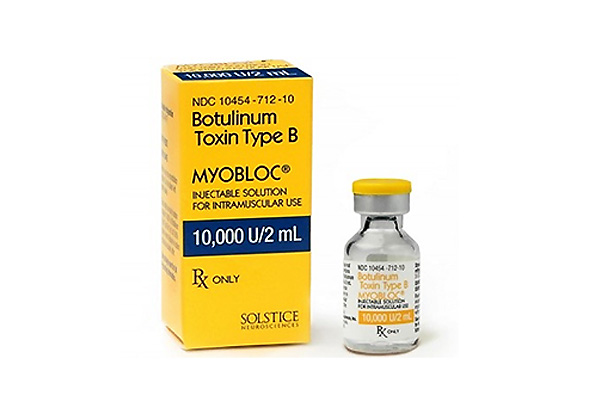
The drug Mioblock, like Botox, is American-made, but it contains botulinum toxin type B.
Most other drugs are almost complete analogues of the above. For example, Azzalure is practically no different from Dysport, Relatox and Neuronox are almost completely identical to Botox. At the same time, many reviews show that despite the similarity of formulations, the results of the use of these drugs may vary. For example, most patients are hurt when they are given Relatox, although they do not experience discomfort with Botox injections. Some, in response to a seemingly similar drug, have unexpected side effects.
In any case, the patient himself does not make sense to choose the drug on his own, focusing solely on prices and reviews of friends. Make a choice should only be a professional cosmetologist, who will conduct the procedure and be responsible for its result. He will be able to evaluate the features of the muscles of the patient, and the anamnesis, and other factors that the patient himself may not even know about.
What can Botox injections be dangerous and what unpleasant consequences can they sometimes lead to
In almost half the cases after Botox administration, patients experience certain undesirable side effects, which for the most part are insignificant and quickly disappear. The patient may be faced, for example, with the fact that he has:
- Small redness and bumps occurred at the injection sites;
- The injection points itch, can hurt, under them there is a sensation of a foreign body;
- Swelling, bruising, and redness appeared in the area of the injected muscles.
As a rule, such consequences and noticeable signs of injection persist for 1-3 days and pass without a trace.
The photo below shows how the face looks right after the Botox administration procedure:
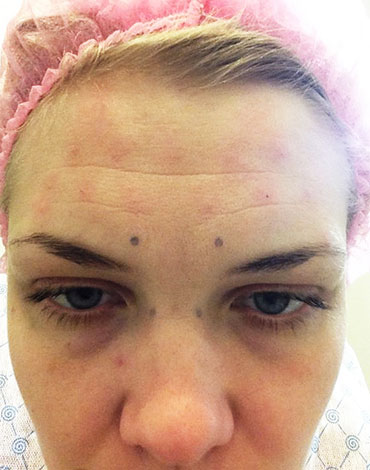
The injection points of the drug and slight redness near them are clearly visible.
More dangerous are the following effects:
- Allergic reactions are the only deadly complications. May develop up to anaphylactic shock;
- Violations of physiological functions due to muscle deactivation. For example, inability to close the eye or take a sip;
- Diplopia - double vision;
- Inflammation and suppuration of injection sites. If at least one of the injection sites has become inflamed, especially with an increase in temperature, you should consult a doctor as soon as possible;
- Respiratory flu-like syndrome. It is not dangerous in itself, but because the patient is trying to treat it with the use of potent drugs.
Finally, there are a number of consequences that are definitely not dangerous, but which patients fear most - unforeseen facial expressions. This may be, for example, asymmetry in muscle contraction, deactivation of those muscles that were not planned to be processed, serious changes in facial expression, compensatory effect of antagonist muscles, not considered by the doctor.
Among these consequences, the most famous are:
- "Mephistopheles eyebrows", high raised up after injection only in the lower part of the forehead. In this case, the frontal muscle, left without an antagonist, raises eyebrows;
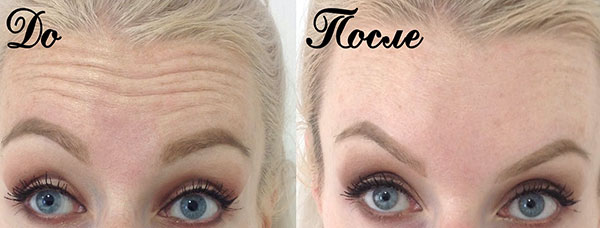
One of the consequences of botulinum therapy can be unnaturally high raised eyebrows.
- “Tired face” with partial ptosis (drooping eyelids);
- Eye completely closed by an eyelid;
- “Sad face” when lowering the corners of the lips;
- “Wax mask” when facial expressions are absent or visibly limited when expressing emotions;
- Inversion of the eyelid, in which the mucous membrane underneath is exposed.
Most of these defects arise due to the doctor’s mistakes either at the stage of examining the face and marking points for injections, or at the stage of drug administration. If both diagnostics and injections are carried out correctly, facial expression disorders are extremely rare and occur only due to the unpredictable reaction of the patient's body to the drug.
Who can get botulinum toxin injections, and who should not
Like any injection technique, botulinum therapy has its contraindications. They can be absolute, when a person can never inject Botox at all, and temporary, when injections are contraindicated at a particular moment due to the characteristics of the patient's condition.
Absolute contraindications include:
- An allergy to botulinum toxin preparations. It can be caused both by the toxin itself and by excipients - albumin, gelatin, maltose and others contained in a particular drug;
- Myasthenia gravis;
- Paresis of the muscles of the face, damage to the facial nerves;
- Diabetes;
- Ocular hernia;
- Tendency to keloid scarring of the skin.
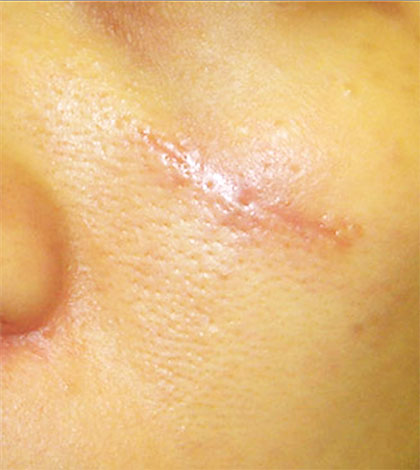
If the skin is prone to keloid scarring, injecting drugs containing botulinum toxin is prohibited.
With them, the consequences of injections can be either unpredictable or very undesirable.
It is temporarily impossible to do Botox injections with:
- Pregnancy
- Acute infectious and inflammatory diseases, including acute respiratory viral infections, hepatitis and others;
- Oncology;
- Reception of antibiotics, muscle relaxants, anticoagulants and some other drugs;
- In parallel, other invasive or just heavy procedures.
It is also undesirable to give injections to those areas of the skin where there are infectious rashes or acne. For example, if it is supposed to remove wrinkles on the forehead and this is where a large number of pustules are located, the procedure should be postponed.
In the absence of contraindications, botulinum toxin injections can be given to anyone aged 3 to 65 years. Sometimes medical procedures are prescribed even for children of the first years of life.
Procedure and rehabilitation after them
Botox injections are relatively simple and do not require special preparation from the patient. It is enough to sign up for a procedure with a cosmetologist and come to the clinic at the indicated time.
The procedure itself begins with a study of the face and the patient’s defects. At this stage, the beautician evaluates the appropriateness of using botulinum toxin in general, studies the specifics of the location of the muscles on the patient’s face, draws up a diagram of the points of drug administration and selects the right amount of funds.

Before you start injecting botulinum toxin, a specialist carefully examines the patient's face.
After that, the patient signs an informed consent for the procedure, and the doctor prepares the drug. Most products are lyophilizates for the preparation of a solution for intramuscular administration, which must be diluted with water in order to obtain a preparation ready for administration. The doctor selects the concentration and dosage of the drug based on the planned administration schedule and other criteria.
The minimum number of administered units of the drug can be any, a maximum of 70-80 Botox units or 100-110 Disport units are introduced at a time. As a rule, the standard dose for eliminating wrinkles on the bridge of the nose or forehead is 20-25 units, in the area of the entire upper third of the face - 30-45 units of Botox or its analogues.
Syringes with very thin needles are used to inject the solution. According to most patients, the injections themselves are either generally painless or feel like a slight tingling sensation. Patients sometimes experience severe pain when setting Relatox injections or with heightened sensitivity. In such cases, the doctor may lubricate the injection site with lidocaine or apply ice to them.
Depending on the size of the injected muscle, the drug is injected under the skin at different depths - from 1 to 9 mm.The rate of diffusion of the drug and the strength of the manifesting effect depend on the depth of administration. Injections are carried out one after another, special intervals between them are not done. Simultaneously with the introduction of the solution, the doctor can massage the injection site a little, controlling the distribution of fluid in the tissues.
It is interesting that in order to eliminate a specific wrinkle, an injection is made not in the crease itself, but in the muscle, which can be somewhat away from it.
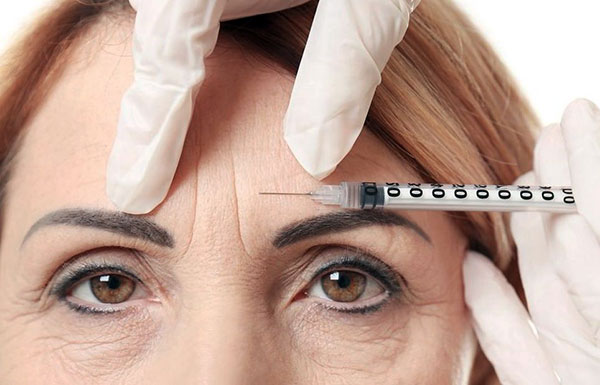
Botulinum therapy involves the introduction of the drug not into the wrinkle itself, but into the muscle, due to which this hall was formed.
Botox injection technique is quite complicated and requires thorough knowledge of the anatomy of the face. The doctor, in particular, should have a good knowledge of the depth of different muscle fibers and their layout in order to inject the drug into the target fiber.
On a note
It is the high requirements for the cosmetologist’s level of training that explain why Botox cannot be injected on its own at home. Even if you collect all the necessary equipment at home, the success of the procedure will be fully determined by the experience and knowledge of the person administering the injections. At least he should have a medical education and knowledge of the anatomy of the face, in the ideal case he should undergo special training in the technique of administering botulinum toxin preparations for cosmetic purposes. Just learning how to properly inject the drug under the skin here will not be enough. For the same reason, it is undesirable to make injections in beauty salons - good specialists work only in clinics, and the clinics themselves have the right to provide services only if there are certificates and contracts with manufacturers of botulinum toxin preparations.
The whole procedure usually takes from 20 to 50 minutes, in rare cases, longer. After it, the patient remains in the chair for half an hour and the doctor watches him, so that in case of the development of an acute allergic reaction, he can take action. If undesirable consequences do not occur, the session ends.
After Botox injections, the patient should avoid any activity that can lead to muscle tension, which were injected, and a rush of blood to them. For example, when injecting into the muscles of the face, you can’t lie down for 3 hours, play sports and bend over for a long time, stay in the sun for a long time in the summer, sunbathe on the beach and in the solarium, take a hot bath or take a steam bath in the sauna. It is not recommended to drink alcohol and spicy foods at least a day after the procedure.

During the day after botulinum therapy, you can not drink alcohol and spicy dishes.
It is also impossible to inject Botox and fillers in one day, or immediately carry out other cosmetic procedures immediately after botulinum therapy - lifting, peeling, rhinoplasty or blepharoplasty, tattooing and the like.
For Botox injections in different parts of the body, the restrictions during the rehabilitation period may be different.
The rules of conduct after botulinum therapy may seem quite strict, but it is their violations that often lead to the appearance or intensification of side effects.
The most common myths and misconceptions about Botox injections
As you can see, Botox injections are quite effective, in many cases a necessary and fairly low-risk procedure. Nevertheless, there are many myths and prejudices about it, because of which many people are unjustifiably afraid to carry it out.
The most common of these fears is the fear of a motionless, as if frozen face, of that same “wax mask”. Despite the fact that such a consequence is quite real, in reality it develops extremely rarely - very large quantities of the drug and its completely illiterate use are required to immobilize the entire face. Any more or less competent cosmetologist will not make such a blatant mistake.
A similar concern is a swollen, swollen face, about which some even say "downloaded by Botox."The photo shows an example of what many patients fear:

In fact, this myth is completely implausible: persistent edema can cause permanent and incorrectly entered fillers, but not Botox. Botulinum toxin preparations, in principle, are not administered in such quantities that they are capable of causing similar effects.
The real risk is skin necrosis. Only it develops not with Botox injections, but with the introduction of counterfeit, which is issued as Botox in some clinics. To avoid this, you should contact those clinics where acquaintances you can trust who have successfully done these procedures.
Finally, Botox cannot affect the brain and cause schizophrenia. It does not cause addiction, similar to alcoholism, does not lead to poisoning of the body and does not provoke cancer. All such horror stories are usually the arguments of ardent opponents of botulinum toxin injections, in which quite reasonable arguments in the discussion end.
So, if Botox is needed to achieve a specific cosmetological or therapeutic result, it can, and sometimes even needs to be injected. It is only important for this to find a good cosmetologist, not to chase unreasonable savings and follow all the instructions of the chosen specialist.
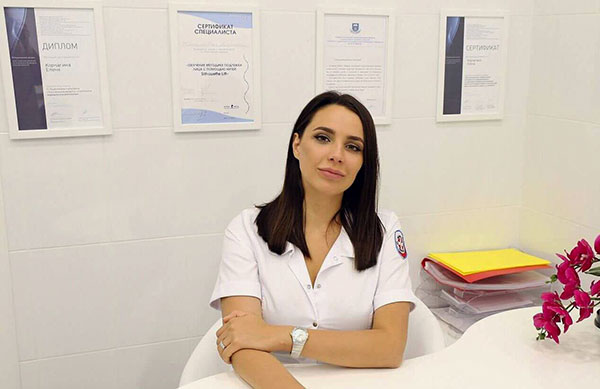
If a woman decided on botulinum therapy, then the most important thing is to find a highly qualified specialist in order to avoid negative consequences after the procedure.
Feedback
I am terribly afraid of injections after I was injected with some kind of ailing antibiotic as a child. Therefore, for a long time I did not dare to start injecting Botox. Stayed up to 36 years, so there were such stripes on the forehead that are even visible in a completely calm state. Others start stabbing at 30, when wrinkles are just outlined, and I already have frank creases on my forehead and in my eyebrows. There are no crow's feet, some kind of radial wrinkles, pah-pah-pah. In general, I decided to pierce. I didn’t go to the cheapest doctor in St. Petersburg; her Botox unit costs 260 rubles. Such an average market price. It’s good that I didn’t choose the cheapest one, they did everything very competently. The doctor asked me to wrinkle this or that part of the face for about 30 minutes, felt it, said that she was conducting a special test. Then she started stabbing. Everything got colder when I saw the syringe. But surprisingly, there was nothing at all ill. You feel the injection, but it's like a mosquito biting. Tolerantly, only after the procedure you really want to scratch your face strongly, but this can not be done. As a result, I got 11 units for 2860 rubles, the result is very good. With a relaxed face, there are no wrinkles at all. When wrinkling on purpose, a little appear on the forehead, near the eyebrows, but insignificant. The doctor said that this was the calculation: if removed completely, the face will look fake. An interbrow also appears, only if I purse specifically, because it does not exist at all.
Irina, St. Petersburg
Cognitive video about the practice of injecting Botox
Cosmetologist's advice on botulinum therapy

